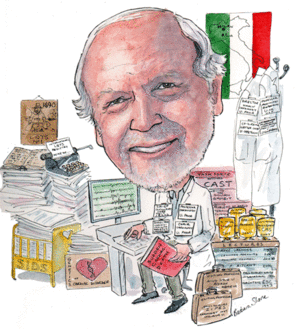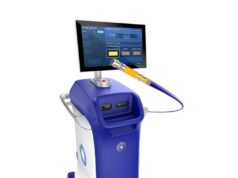
Peter Schwartz tells Cardiac Rhythm News about loving his research, being best man at a patient’s wedding and having an article about golf published in a medical journal.
How did you become interested in medicine? Why cardiology and electrophysiology?
My father was a physician and several members of my family have contributed to medicine. My interest in sudden arrhythmic death was accidental and related to my first patient with the long QT syndrome (LQTS). The fact that the Department of Medicine in which I began work was focused on cardiology played a major role, but I might have also been subconsciously influenced by my father’s death at age 57 due to coronary artery disease.
Who has inspired you in your career and what advice of theirs do you remember today?
I vividly remember three things said by three people who influenced me significantly. My senior mentor, Professor Alberto Zanchetti, once told me: “Whenever you design a new project, if you think that in case of success you cannot publish the results in the number one journal in the field, drop it, do not even start.” My junior mentor, Professor Alberto Malliani, once told someone in my presence that “I do not know” is never a bad answer, provided that one then goes to the library to find out. Arthur “Buzz” Brown once interrupted a young fellow who was describing a research project and said “So what?” The fellow did not know what to answer and it was a pitiful situation. I vowed to myself to never plan a project without having a clear answer to the “So what?” question.
Could you describe some memorable cases you have treated?
The clinical case that turned my entire life around was that of my first LQTS patient, “A”. In 1971, she was admitted at age nine to one of the beds I was partially responsible for as a very junior physician because her 17 year old sister had died suddenly on a live popular TV quiz programme. Both sisters had often fainted whenever they were scared or emotionally stressed.
She looked quite normal, besides a striking prolongation of the QT interval which did not seem to impress the senior physicians. Not one of the doctors from the leading cardiology departments in Italy offered a diagnosis. After extensive inquiries and many hours in the library where a 1964 editorial in The Lancet put me on the right track, I made the diagnosis of LQTS. Less than two dozen such patients had been reported at that time. I became very involved with this little patient, especially after having interrupted one of her cardiac arrests by the thump method.
One day, when she was scared, I noted the appearance of T wave alternans on the electrocardiogram. Having access to cats in my experimental lab I set out to reproduce both QT interval prolongation and T wave alternans by manipulations of the sympathetic nervous system. Eventually I succeeded in reproducing both phenomena in anaesthetised cats by stimulating the left stellate ganglion.
Meanwhile, despite therapy with full dose beta-blockers and a major reduction in syncopal episodes, “A” still had events and a cardiac arrest. I proceeded with left cardiac sympathetic denervation and, despite the non-hostile scepticism of my mentors, surgery was performed on 25 March 1973. Since then, she has remained free of syncopal episodes. My life changed because I devoted most of my research time to study LQTS and the relationship between the autonomic nervous system and sudden death.
I was the best man at this patient’s wedding and she comes once a year to see me for her regular check-up; meanwhile we found that she is a LQT1 patient, as are many of her family members. She calls me her second father and I tell her that she changed my life.
Could you share one of your proudest moments with us?
I have been lucky in my profession, and as a consequence I received many recognitions of which I was and am proud because my rather narcissistic nature enjoys these moments. Certainly one of the most significant was the invitation in 1994 to give the Paul Dudley White International Lecture at the American Heart Association, the greatest honour given by American cardiology to a foreign physician.
Another important recognition was to become the first European investigator selected to give a named lecture at the ESC for the second time: the first was the Grüntzig lecture in 1993 and the second was the Laennec lecture in 2008. These moments, however, are bittersweet. The joy is always accompanied by the truly desperate thought that I was never able to show anything to my father to make him proud (he died when I was 21 years old) and that no matter what I accomplish, there will never be a remedy. A battle lost forever, and possibly a reason for my never-ending inner drive.
Long QT syndrome is one of your key areas of research. How has the treatment of this condition evolved since you began your career?
The transformation that has taken place in our understanding of LQTS is simply mind boggling. When I first became involved, almost nothing was known about this disease. Having no idea about its causes, there was a smorgasbord of therapies used, almost all ineffective. Those of us who realised the link between the cardiac events and sympathetic activation did begin to use beta-blockers, and this had a strikingly dramatic effect in reducing mortality.
Left cardiac sympathetic denervation has proven to be a most effective treatment, when beta-blockers fail, and for the patients at highest risk, we now have the implantable cardioverter defibrillators. However, the true revolution came with the discovery in 1995 and 1996 of the first three major genes for LQTS. The realisation that the disease is due to a genetic defect which subtly alters the ionic control of repolarisation has represented a landmark change in cardiology and arrhythmology. Our field will never be the same. LQTS truly represents a Rosetta stone for sudden cardiac death.
What other research are you developing at the moment?
My research now continues in the general direction of what I have done so far but it focuses on “modifier genes”, for both LQTS and sudden death in ischaemic heart disease. My interest is in unmasking those relatively common genetic variants that, in the presence of a given disease, increase or reduce the risk of dying suddenly. As to LQTS, most of this work is carried out in South Africa where we follow over 500 descendants of a Dutchman who went there in 1690, was affected by LQT1, and has had his genes and his mutation spreading in a way that we can now study hundreds of individuals all carrying the same identical mutation but having a different clinical outcome because even though most have life-threatening arrhythmias some (20%) go through life without symptoms. As for ischaemic heart disease, we have designed and initiated a large prospective study called PREDESTINATION aimed at enrolling 4000 patients with a first myocardial infarction, complicated or not, by ventricular fibrillation.
A genome-wide study of their DNA will provide, I am pretty sure, the key to identify early on those individuals carrying probably a cluster of common genetic variants which could be without effect in healthy persons but that could favour the occurrence of sudden death during a first ischaemic episode. This would lead to aggressive preventive strategies and a major reduction of these unexpected, and untimely, deaths.
Outside of medicine, what other interests do you have?
Besides good books, good music, developing friendships with people of different cultures and travelling to special places, I love sport. For many years, I favoured tennis and downhill skiing; for over 20 years my passion has been golf. I am a member of the Continental European Golf Team for Cardiology, where I served as captain for six years, and every two years we have a four-day match against the United States and the British Islands. The William Harvey Trophy is indeed the equivalent of the Ryder Cup for Cardiology. The proudest moment was when in 2002, I succeeded in publishing our victory in The Lancet. It is not terribly difficult to publish a good clinical trial in The Lancet but to have them publish a two column article on golf was a class act!
Fact File
Present positions
- Professor and chairman of Cardiology, University of Pavia
- Director of the School for the Board in Cardiology, University of Pavia
- Chief of the Coronary Care Unit, Fondazione IRCCS Policlinico San Matteo
- Director of the Cardiovascular Genetics Laboratory, IRCCS Istituto Auxologico Italiano
- Professor of Physiology and Biophysics at the University of Oklahoma
- Extraordinary professor in Internal Medicine, University of Stellenbosch
- Co-director, Hatter Institute of Heart Research of the University of Cape Town
- Visiting professor for the Sudden Death Chair, King Saud University
Professional societies
Fellow:
American Heart Association and the Council on Clinical Cardiology
American College of Cardiology
Heart Rhythm Society
European Society of Cardiology
Cardiac Arrhythmia Society of South Africa
International scientific distinctions
2010 Joan and Douglas Zipes visiting professor, Krannert Institute of Cardiology, Indiana University School of Medicine
2010 Keynote lecture, Congress of the Japanese Circulation Society, Japan
2009 Robert L Krakoff international lecture in cardiovascular medicine at Brigham and Women’s Hospital Cardiovascular Grand Rounds, USA
2008 Renè Laennec Lecture on Clinical Cardiology, annual meeting of the European Society of Cardiology
2007 Received the Outstanding Achievement Award at the European Cardiac Arrhythmia Society
2007 Philippe Coumel Lecture in recognition of contribution to the field of cardiac arrhythmias and pioneering work in clinical electrocardiology
2007 15th Annual Leonard Horowitz Memorial Lectureship
2005 Arrigo Recordati Prize
2004 Keynote P Rijlant Lecture, International Congress on Electrocardiology, Japan
2001 Michel Mirowski Award
2001 Distinguished Scientist Award 2001, NASPE
1995 4th Fourth Gordon K Moe visiting professor, Masonic Medical Research Laboratory, Utica, New York
1994 Paul Dudley White International Lecture, American Heart Association Scientific Sessions
1993 Grüntzig lecture, Congress of the European Society of Cardiology
Editorial board member and/or reviewer
Circulation, Heart Rhythm, Europace, Heart and Vessels, Journal of Cardiovascular Medicine, The New England Journal of Medicine, The Lancet, Circulation Research, American Journal of Physiology, American Journal of Cardiology, American Heart Journal, The Journal of the American College of Cardiology, PACE, Cardiovascular Research, European Heart Journal, Heart, Pflügers Archives, Cardiovascular Drugs and Therapy, Italian Heart Journal, Basic Research in Cardiology, Sleep, Pediatric Research, The Journal of Clinical Investigation, Trends in Cardiovascular Medicine, Journal of Ambulatory Monitoring, Cardiology in the Elderly, Coronary Artery Disease.









